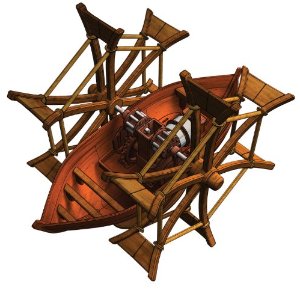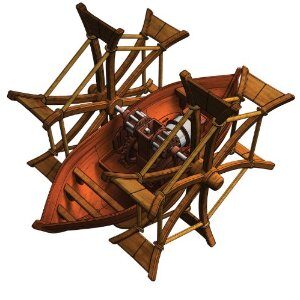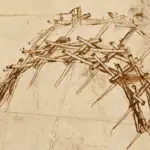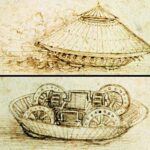Da Vinci paddle boat designs were ahead of their time, showcasing Leonardo da Vinci‘s genius in engineering. These creations allowed boats to move faster and be easier to steer than others of the era.
Designed with rotating paddles operated by the sailors, these boats demonstrated the brilliance of utilizing human power for efficient travel.
For those curious about historical innovations, exploring da Vinci’s paddle boat offers a fascinating glimpse into the inventor’s mind. His work influenced various transportation methods we see today, revealing how imagination and engineering come together to solve practical problems.
The mechanics of the paddle boat, driven by the sailors’ efforts, highlight da Vinci’s talent for merging art and science.
The design utilized a system where the paddles were powered by either hand or foot. This not only made the vessel more manageable but also increased its speed on water compared to traditional boats of the time.
Leonardo da Vinci’s Innovations
Leonardo da Vinci’s ideas have left a lasting impact on engineering and design, showcasing his genius and creativity. His concepts, such as the paddlewheel boat, were pioneering for their time and provided a foundation for future inventions.
The historical context of these innovations reveals how advanced his thinking was compared to his contemporaries.
Influence on Engineering and Design
Leonardo da Vinci Paddle Boat is a testament to his forward-thinking in engineering. His designs, including the paddle wheel boat, introduced new concepts in mechanics.
These ideas influenced not only his era but also modern engineering practices.
The paddle wheel mechanism he imagined is considered a precursor to later vessels, like the paddle steamer, which emerged hundreds of years after his time.
The importance of these designs lies in their detailed execution without modern technology. He was ahead of his time, thinking beyond what was possible in the 15th century.
Models and drawings from his notebook show his approach to creating a vessel powered by human effort rather than wind—a revolutionary navigation idea.
Historical Context of the Da Vinci Paddle Boat
In Leonardo’s time, the predominant modes of water transport relied heavily on sails. The concept of a machine that did not depend on the wind, like the da Vinci paddle boat, introduced a novel way to harness human power.
His vision involved sailors using pedals to move a paddle wheel, making the boat move forward.
This concept is reflected in models and kits like the one from the Academy Da Vinci Paddle Boat, showcasing his design brilliance.
Although these innovations never materialized in his lifetime, they laid the groundwork for future developments in naval technology and highlighted the breadth of his creative genius.
Design Specifications of the Paddle Boat
The Leonardo da Vinci Paddle Boat is an innovative creation highlighting intricate mechanical systems and thoughtful design. This design includes detailed features and construction techniques that were revolutionary for their time.
Mechanics of Paddle Wheel Function
In Da Vinci’s design, a mechanical spring system drives the paddle wheel. This mechanism uses a combination of gears and pedals to move the wheels.
The paddles are attached to large wheel-shaped structures which rotate, enabling the boat to glide through water.
The Da Vinci Paddleboat requires no external power source, relying solely on its internal system. Thus, it demonstrates its ingenuity in efficiently utilizing human power.
This foundational approach set the stage for future paddle wheel boats and steamers developments.
Materials and Construction Techniques
Leonardo da Vinci used wood and metal to construct his paddle boat.
Wood provided structural integrity, while metal components like springs and gears enabled movement.
These da Vinci paddle boat parts were carefully designed to work harmoniously, ensuring durability and performance.
Modern reproductions, such as the Academy Da Vinci Paddle Boat, show how easily the boat can be assembled without tools or glue, emphasizing its clever design.
Da Vinci’s construction methods highlight his forward-thinking approach to creating machinery that was both practical and straightforward to construct.
Impact and Legacy
The Leonardo da Vinci Paddle Boat has significantly influenced maritime technology and education. Examining its contributions and educational use can help one better understand its lasting impact.
Contributions to Modern Maritime Engineering
Leonardo da Vinci’s innovative design of the paddle-wheel boat laid the groundwork for future developments in marine propulsion.
While the paddle steamer eventually became popular in the 19th century, da Vinci’s earlier concepts showed propulsion potential using a paddle wheel system.
His vision led to further research and inventions in marine engineering. Da Vinci’s paddle mechanisms inspired modern developments in boat design.
This exploration also reinforced the idea that alternative propulsion methods could be both practical and efficient long before the age of steam engines.
Educational Implications and Replicas
The da Vinci paddle boat has been recreated in educational settings, demonstrating the historical significance of da Vinci’s inventions.
These replicas help students engage with engineering concepts by providing hands-on learning opportunities.
These models often come with detailed guides, allowing learners to understand how early engineering concepts have influenced modern designs.
Studying these replicas enhances one’s understanding of Leonardo da Vinci’s innovative mind. It illustrates how his forward-thinking ideas continue to inspire students and spark curiosity about the foundations of technology.
Frequently Asked Questions
The Da Vinci paddle boat features an innovative design with mechanics based on Leonardo da Vinci’s concepts. The information provided will cover how it works, how it’s powered, and other intriguing details about these unique boats.
How does a Da Vinci paddle boat work?
The Da Vinci paddle boat uses paddle wheels powered by a mechanical spring and pedals.
When the pedals are moved, they engage the mechanism, turning the paddle wheels and propelling the boat forward.
This design showcases da Vinci’s ingenious approach to combining simple mechanisms for movement.
What is the difference between a pedal boat and a paddle boat?
A pedal boat is typically powered by pedals pushed by the rider’s feet, similar to a bicycle. Meanwhile, a paddle boat relies on paddles that may be operated manually or powered by a mechanical system. The Da Vinci paddle boat uses a combination of paddles and mechanical springs for motion.
What is a paddle boat crossword clue with 6 letters?
In crosswords, “paddle boat” often results in the answer “gondola,” which fits in six letters. However, the correct answer may vary based on the specific puzzle and context.
Who invented the paddlewheel boat?
A single individual did not invent the paddlewheel boat.
While Leonardo da Vinci designed concepts for paddle boats around 1490, paddlewheel technology became more widely used in the 18th and 19th centuries, notably in steamboats.
Can you flip a paddle boat?
Paddle boats can be stable, but like any small watercraft, they can be flipped if they experience uneven weight distribution or rough water.
Although not common, safety precautions should still be taken to prevent accidents.
How is a paddle boat powered?
Paddle boats can be powered in various ways, including by manual labor (such as pedaling) or mechanical methods like springs or motors. The Da Vinci paddle boat uses a mechanical spring and pedal system.
How does a paddle boat operate?
A paddle boat operates by rotating paddles through the water, providing thrust to move the ship.
Individuals can manually operate it using foot pedals or a mechanical system, as in some historical designs, such as the Da Vinci paddle boat.
How do you control a paddle boat?
Control of a paddle boat is generally achieved using a rudder or a steering mechanism.
In pedal-powered paddle boats, turning the rudder by hand directs the boat, while adjustments to paddle speed can also help with navigation.
How does a paddle boat float?
Paddle boats float due to buoyancy provided by their design and materials.
They often have a wide, stable hull that helps displace enough water to keep the boat afloat, allowing it to carry weight efficiently on the water’s surface.
How does a paddle boat steer?
Steering a paddle boat usually involves using a rudder. The operator adjusts the rudder to change direction, often using a handle or a wheel.
The boat’s movement is controlled by changing the direction of the paddles or varying their speed.


 I’m Leonardo Bianchi, the mind behind Leonardo da Vinci's Inventions. Thanks for visiting.
I’m Leonardo Bianchi, the mind behind Leonardo da Vinci's Inventions. Thanks for visiting. 


